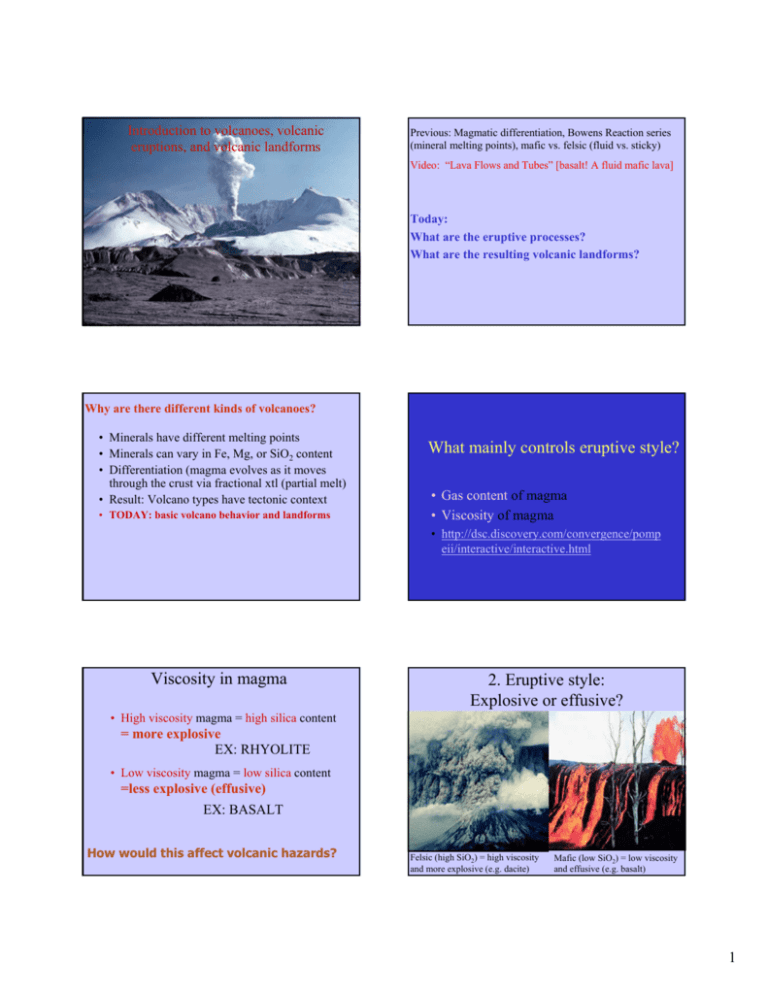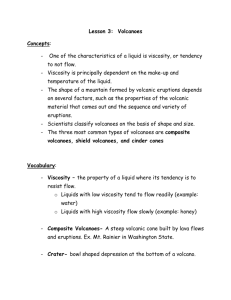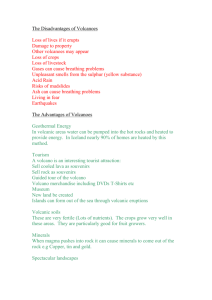What mainly controls eruptive style? Viscosity in magma 2. Eruptive
advertisement

Introduction to volcanoes, volcanic eruptions, and volcanic landforms Previous: Magmatic differentiation, Bowens Reaction series (mineral melting points), mafic vs. felsic (fluid vs. sticky) Video: “Lava Flows and Tubes” [basalt! A fluid mafic lava] Today: What are the eruptive processes? What are the resulting volcanic landforms? Why are there different kinds of volcanoes? • Minerals have different melting points • Minerals can vary in Fe, Mg, or SiO2 content • Differentiation (magma evolves as it moves through the crust via fractional xtl (partial melt) • Result: Volcano types have tectonic context • TODAY: basic volcano behavior and landforms What mainly controls eruptive style? • Gas content of magma • Viscosity of magma • http://dsc.discovery.com/convergence/pomp eii/interactive/interactive.html Viscosity in magma 2. Eruptive style: Explosive or effusive? • High viscosity magma = high silica content = more explosive EX: RHYOLITE • Low viscosity magma = low silica content =less explosive (effusive) EX: BASALT How would this affect volcanic hazards? Felsic (high SiO2) = high viscosity and more explosive (e.g. dacite) Mafic (low SiO2) = low viscosity and effusive (e.g. basalt) 1 Explosive eruption: pyroclastic flow Unzen Volcano, Japan, 1991 Where do volcanoes erupt—and how does this relate to plate tectonics? types of volcanoes and volcanic landforms Shield volcano ex: Mauna Loa; Larch Mtn, OR Shield Volcano (typically basaltic!) Composite volcano (stratovolcano) ex: Vesuvius, Mount Rainier, Popo, Mount Fuji Dome ex. Goat Mountain, Black Buttes & Mt. Shasta (CA) Cinder cones and spatter cones ex: Paracutin, Puu O (Kilauea), Sunset Crater (AZ) Maar volcano Caldera Below: aerial view of Hawaii ex: Battleground Lake, Ubehebe (CA) ex: Yellowstone, Toba, Crater Lake, Long Valley Flood basalt ex: CRBs; Deccan Traps, Siberian Traps Kilauea’s summit caldera, southwest and east rift zones that erupt most of the lava flows, and major fault zones 2 Lower viscosity basaltic lava (mafic) is ~45% to 54% silica Shield Volcanoes Basaltic volcanism in the Cascade Range Effusive eruptions - chiefly lava flows. <= Tumac Mtn shield, NE of White Pass; view to East Clayton (1983) estimated the age of Tumac Mtn at 30 to 20 ka. Builds shield volcanoes --gentle relief + cinder cones. ka = kiloannum Spray Park and Mount Rainier view to the east; 1903 photo by W.P. Romans Kupaianaha lava pond, Kilauea: photo by Pat Pringle, July 1987 Mount Adams composite volcano is constructed on top of a broad shield Larch Mtn shield, OR Underwood Mtn shield, WA Composite volcanoes (aka stratovolcanoes) • • • • • • • Related to subduction zones ~55–65 % silica (intermediate viscosity) Moderately violent explosive behavior ~50/50 ratio of lavas/ fragmental deposits Thick lavas (to 20 or even 100 m) Steep cones; can have domes (implications?) Lahars! (volcanic debris flows) Composite volcano Mount Hood 3 Composite Volcano Where are Composite volcanoes? aka stratovolcano • Ring of Fire (Circumpacific belt) • Mediterranean belt Photo by Pat Pringle May 18, 1980 Plinian eruption column Looking NNW Photo by Bob Krimmel, USGS Mount St. Helens => changed the way we think about composite volcanoes! Mount Rainier from Glacier View Wilderness Mount Baker At composite volcanoes, glacial erosion can increase relief and supply ground-water that contributes to hydrothermal alteration and weakening of the cone. Fig. 7-15, p.157 Fig. 7-16, p.158 4 Martha Sabel, USGS, 1982 Incised canyon on the north flank of Mount St. Helens near north end of 1980 Crater floor; note great percentage of fragmental debris! View looks NNE; photo by Pat Pringle, September, 1982 Fig. 7-18, p.160 Lava domes Summit dome dacite of Kalama age (post AD 1479) Photo by Pat Pringle Basalt of Castle Creek age (~1900 yr B.P.) basaltic dike Crater walls of Mount St. Helens; photos by Pat Pringle; above Note person for scale from south crater rim; right, from top of Lava Dome.) Dacite dome rock of Pine Creek age (~2500 yr B.P.) Mount St. Helens hot dome avalanche of May 9, 1986 Mount Shasta, a composite volcano, and Shastina Mount Shasta’s summit consists of 4 domes Domes Lidar images of crater floor, Sept. 2003 and Sept. 2004 Black Buttes 5 MSH04_dome_from_sugarbowl_10-10_to_11-21-04 Aerial view of Spiral Butte dacite dome at White Pass Clayton ~ 30 – 20 ka; Tom Sisson of USGS estimates its age at ~100 ka Cinder cones Typically basaltic Paricutin, Mexico, 1941 Calderas Mount Katmai caldera lake, below Aniakchak caldera, AK 1.2 Ma basalt lava flows from the Uinkaret Plateau in Grand Canyon 6 Rhyolitic volcanism and calderas • ~65 – 76 % Silica (viscous!!!) Can be very violent and highly explosive Produce mostly pyroclasts/ extensive ash flows Significant % of magma erupts producing calderas Rhyolitic volcanism and calderas • 100 to 1000+ km3 deposit volumes!!! • >138 active in historic times • Examples: Toba, Yellowstone, Campi Flegrei, Long Valley (CA), Crater Lake, Aniakchak • Largest known (Miocene) La Garita in the San Juans (CO) => >3000 km3 !!!!! Volcanoes and human history: Santorini volcano on the island of Thera Fig. 7-23, p.163 Fig. 7-32, p.168 7 Fig. 7-33, p.168 Fig. 7-36, p.169 Lava Creek ash from Yellowstone Caldera, 1,000 km3 Fig. 7-37, p.170 Flood Basalts Flood Basalts (aka Plateau Basalts) Fissure eruptions of basalt—Earth’s largest lava flows CRB surface exposures ~175,000 km2 & extend 400-600 km! Exs: Columbia River Basalt Gp, Deccan Traps, Parana Brazil 8 Features of flows (simplified): pillows and pillow palagonite breccia, colonade, entablature, vesicular top. Entablature Grande Ronde Basalt of the Columbia River Basalt Group as exposed at Table Mountain, Columbia River Gorge; photo by Grand Ronde flow GSOC, 1997, SR 410 Pat Pringle Colonade contact with Miocene Eagle Creek Formation—Table Mtn Columbia River Basalt flows separated by sedimentary interbeds Palagonite pillow delta of Pliocene age, Columbia River Gorge Longview quarry, 2006 Columbia River Basalt flows 9 Sill of Columbia River Basalt on north coast of Oregon; basalt invaded marine sediments of the Miocene coastal plain Volcanic necks—Beacon Rock in Columbia River Gorge Maar volcanoes-created by phreatic eruptions Wind Mountain shallow intrusive body in the Columbia Gorge (~6 Ma). Volcano Hazards •Proximal areas (up to 15 mi) subject to multiple hazards •Lahars and floods affect valleys for many tens of miles •Tephra fall affects areas tens to hundreds of miles, or more, downwind •Excess sediment in watersheds makes channels unstable for years to decades 10 Learning objectives • • • • • What is a volcano? Where do we find volcanoes? (Review) What is the origin of volcanoes? Why do volcanoes erupt? Why do some volcanoes erupt explosively and some non-explosively? • How does eruptive style affect creation of volcanic landforms and volcanic hazards? 11





![Real-Life Volcano Stories [WORD 511KB]](http://s3.studylib.net/store/data/006739804_1-83de3fc62d3d9a8e55249765289fb3f2-300x300.png)
